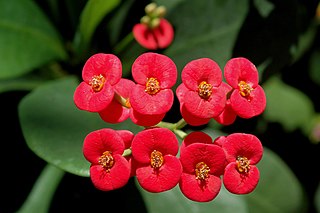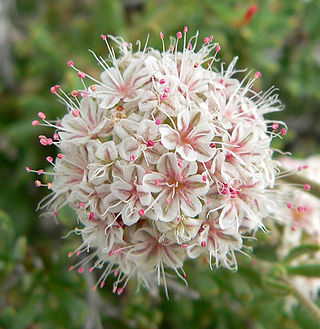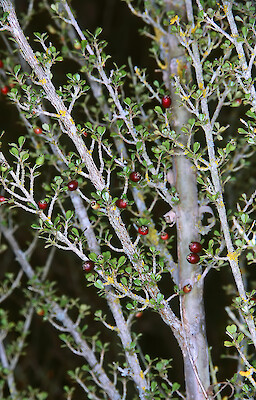
Euphorbia is a large and diverse genus of flowering plants, commonly called spurge, in the family Euphorbiaceae.

Chamaesyce is a subgenus of plants in the family Euphorbiaceae. Recent phylogenetic studies have shown that Chamaesyce is deeply nested within the broader Euphorbia. Specifically, Chamaesyce is very closely related to plants like Euphorbia pulcherrima, the popular poinsettia. Currently, all species have now been reclassified as species of Euphorbia. Specifically, this group now belongs to Euphorbia subgenus Chamaesyce section Anisophyllum. Taxonomically speaking, Chamaesyce is considered a synonym of Euphorbia.

Euphorbia milii, the crown-of-thorns, Christ plant or Christ's thorn, is a species of flowering plant in the spurge family, Euphorbiaceae, native to Madagascar. The specifies commemorates Baron Milius, once Governor of Réunion, who introduced the species to France in 1821.

Euphorbia albomarginata, whitemargin sandmat or rattlesnake weed, is a small low-growing perennial, in the spurge family native to desert, chaparral, and grassland habitats of southwestern North America, from southern and central California to Northern Mexico and Louisiana.

Eriogonum fasciculatum is a species of wild buckwheat known by the common names California buckwheat and flat-topped buckwheat. Characterized by small, white and pink flower clusters that give off a cottony effect, this species grows variably from a patchy mat to a wide shrub, with the flowers turning a rusty color after blooming. This plant is of great benefit across its various habitats, providing an important food resource for a diversity of insect and mammal species. It also provides numerous ecosystem services for humans, including erosion control, post-fire mitigation, increases in crop yields when planted in hedgerows, and high habitat restoration value.

Croton alabamensis, known as Alabama croton, is a rare species of flowering plant in the spurge family, Euphorbiaceae, that is endemic to Texas and Alabama in the Southeastern United States. It has two varieties whose ranges are separated by more than 1000 km: Croton alabamensis var. alabamensis is found in two central Alabama counties, while Croton alabamensis var. texensis is found in three counties in Texas.

Frankenia pauciflora, the common sea-heath or southern sea-heath, is an evergreen shrub native to southern Australia. It is part of the Frankenia genus of the Frankeniaceae family.

Pachycormus is a monotypic genus of flowering plants in the cashew family commonly known as the Baja elephant tree, torote blanco, or copalquín. The single species Pachycormus discolor is endemic to the Baja California peninsula, with three varieties. This sarcocaulescent tree or shrub is characterized by its unique gnarled growth habit, skin-like exfoliating bark, and succulent nature, whose appearance has been colorfully described as "the proboscis of an elephant holding a nosegay," a "huge radish protruding from the ground," or "grotesque resemblances of the flexed limbs of a corpulent human being." This drought-deciduous species spends most of the year dormant, but following rains pinnate green leaves emerge, and in the late spring to summer the leaves yellow, fall, and give way to bright red, cream, or pink flowers that give it a striking appearance in bloom.

Euphorbiaceae, the spurge family, is a large family of flowering plants. In English, they are also commonly called euphorbias, which is also the name of the type genus of the family. Most spurges, such as Euphorbia paralias, are herbs, but some, especially in the tropics, are shrubs or trees, such as Hevea brasiliensis. Some, such as Euphorbia canariensis, are succulent and resemble cacti because of convergent evolution. This family has a cosmopolitan global distribution. The greatest diversity of species is in the tropics; however, the Euphorbiaceae also have many species in nontropical areas of all continents except Antarctica.
Euphorbia deppeana is a rare species of flowering plant in the family Euphorbiaceae known by the common names Deppe's broomspurge and Oahu sandmat. It is endemic to Oʻahu, Hawaii, where it is known from only one population in moist shrublands on Nuʻuanu Pali. Like other native Hawaiian euphorbs it is called ʻakoko locally.
Euphorbia eleanoriae is a rare species of flowering plant in the euphorb family known by the common name Nā Pali sandmat. It is endemic to Kauaʻi, Hawaii. Like other native Hawaiian euphorbs it is called ʻakoko locally. This plant was only discovered in 1992 and described to science in 1996 as Chamaesyce eleanoriae. At that time there were fewer than 500 plants known, all occurring in small populations scattered across the sheer cliffs along the Nā Pali Coast of Kauaʻi. By 2001 the total population had already dropped; only three populations were found, for a total of fewer than 50 plants. The plant was federally listed as an endangered species of the United States in 2010.
Euphorbia herbstii is a rare species of flowering plant in the family Euphorbiaceae known by the common name Herbst's sandmat. It is endemic to Oʻahu, Hawaii, where it is rapidly disappearing. Like other Hawaiian euphorbs, this plant is known locally as ʻakoko. It is a federally listed endangered species of the United States.

Euphorbia kuwaleana is a rare species of flowering plant in the euphorb family known by the common name kokomalei. It is endemic to Oahu, Hawaii, where it is known only from a four-kilometer stretch of the Waianae Range. Like other Hawaiian euphorbs, this plant is known locally as `akoko. It is a federally listed endangered species of the United States.
Euphorbia remyi is a rare species of flowering plant in the family Euphorbiaceae. It is known by the common name Remy's sandmat locally as ʻakoko. It is endemic to the island of Kauaʻi in Hawaii, where it grows in mixed mesic forests, wet forests and bogs from 150 to 900 m.

Euphorbia skottsbergii is a rare species of flowering plant in the euphorb family known by the common names coastal sandmat and Skottsberg's broomspurge. It is endemic to Hawaii, where it is found in coastal shrublands on Oʻahu, Molokaʻi, Maui, and Kahoʻolawe. Like other Hawaiian euphorbs, this plant is known locally as ʻakoko.

Kadua cookiana is a rare species of flowering plant in the coffee family known by the common names 'awiwi and Cook's bluet. It is endemic to Hawaii, where it is known only from Kauai, having been extirpated from Molokai and Hawaii. It is a federally listed endangered species of the United States.

Kadua st-johnii is a rare species of flowering plant in the coffee family known by the common name Nā Pali beach starviolet. It is endemic to Hawaii, where it is known only from the Nā Pali coast of Kauai. It is a federally listed endangered species of the United States.

Holodiscus dumosus is a species of flowering plant in the rose family, with the common names mountain spray, rock-spiraea, bush oceanspray, and glandular oceanspray.

Euphorbia psammogeton, commonly known as sand spurge, is a flowering plant in the family Euphorbiaceae. The specific epithet derives from the Greek psammos (“sand”) and geiton (“neighbour”), alluding to the typical habitat.

Lophomyrtus obcordata, commonly known by its Māori name rōhutu or tutuhi, is a species of flowering plant in the family Myrtaceae. It is endemic to New Zealand, usually found in lowland forest. Lophomyrtus comes from the ancient Greek lóphos (crest), meaning bunches; and Myrtus (myrtle) meaning myrtle tree. Obcordata is associated with a heart-shaped leaf, attached to the peduncle by the pointed end.


















